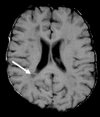Advanced magnetic resonance imaging techniques to better understand multiple sclerosis
- PMID: 28510010
- PMCID: PMC5425675
- DOI: 10.1007/s12551-010-0031-6
Advanced magnetic resonance imaging techniques to better understand multiple sclerosis
Abstract
Magnetic resonance imaging (MRI) has considerably improved the diagnosis and monitoring of multiple sclerosis (MS). Conventional MRI such as T2-weighted and gadolinium-enhanced T1-weighted sequences detect focal lesions of the white matter, damage of the blood-brain barrier, and tissue loss and inflammatory activity within lesions. However, these conventional MRI metrics lack the specificity required for characterizing the underlying pathophysiology, especially diffuse damage occurring throughout the whole central nervous system. To overcome these limitations, advanced MRI techniques have been developed to get more sensitive and specific parameters of focal and diffuse brain damage. Among these techniques, magnetization transfer imaging, diffusion MRI, functional MRI, and magnetic resonance spectroscopy are the most significant. In this article, we provide an overview of these advanced MRI techniques and their contribution to the better characterization and understanding of MS.
Keywords: Diffusion MRI; Functional MRI; MR spectroscopy; MRI; Magnetization transfer imaging; Multiple sclerosis.
Figures






Similar articles
-
The role of magnetic resonance techniques in understanding and managing multiple sclerosis.Brain. 1998 Jan;121 ( Pt 1):3-24. doi: 10.1093/brain/121.1.3. Brain. 1998. PMID: 9549485 Review.
-
Recent developments in imaging of multiple sclerosis.Neurologist. 2011 Jul;17(4):185-204. doi: 10.1097/NRL.0b013e31821a2643. Neurologist. 2011. PMID: 21712664 Review.
-
In-vivo tissue characterization of multiple sclerosis and other white matter diseases using magnetic resonance based techniques.J Neurol. 2001 Dec;248(12):1019-29. doi: 10.1007/s004150170020. J Neurol. 2001. PMID: 12013577 Review.
-
Magnetic resonance imaging monitoring of multiple sclerosis lesion evolution.J Neuroimaging. 2005;15(4 Suppl):22S-29S. doi: 10.1177/1051228405282243. J Neuroimaging. 2005. PMID: 16385016 Review.
-
Characterization of tissue damage in multiple sclerosis by nuclear magnetic resonance.Philos Trans R Soc Lond B Biol Sci. 1999 Oct 29;354(1390):1675-86. doi: 10.1098/rstb.1999.0511. Philos Trans R Soc Lond B Biol Sci. 1999. PMID: 10603619 Free PMC article. Review.
Cited by
-
Biomedical Applications of Gadolinium-Containing Biomaterials: Not Only MRI Contrast Agent.Adv Sci (Weinh). 2025 May;12(20):e2501722. doi: 10.1002/advs.202501722. Epub 2025 Apr 25. Adv Sci (Weinh). 2025. PMID: 40279569 Free PMC article. Review.
References
-
- Arnold DL, De Stefano N, Narayanan S, Matthews PM. Proton MR spectroscopy in multiple sclerosis. Neuroimaging Clin N Am. 2000;10(4):789–798. - PubMed
-
- Audoin B, Davies G, Rashid W, Fisniku L, Thompson AJ, Miller DH. Voxel-based analysis of grey matter magnetization transfer ratio maps in early relapsing remitting multiple sclerosis. Mult Scler. 2007;13(4):483–489. - PubMed
-
- Audoin B, Guye M, Reuter F, Au Duong MV, Confort-Gouny S, Malikova I, Soulier E, Viout P, Cherif AA, Cozzone PJ, Pelletier J, Ranjeva JP. Structure of WM bundles constituting the working memory system in early multiple sclerosis: a quantitative DTI tractography study. Neuroimage. 2007;36(4):1324–1330. doi: 10.1016/j.neuroimage.2007.04.038. - DOI - PubMed
LinkOut - more resources
Full Text Sources

